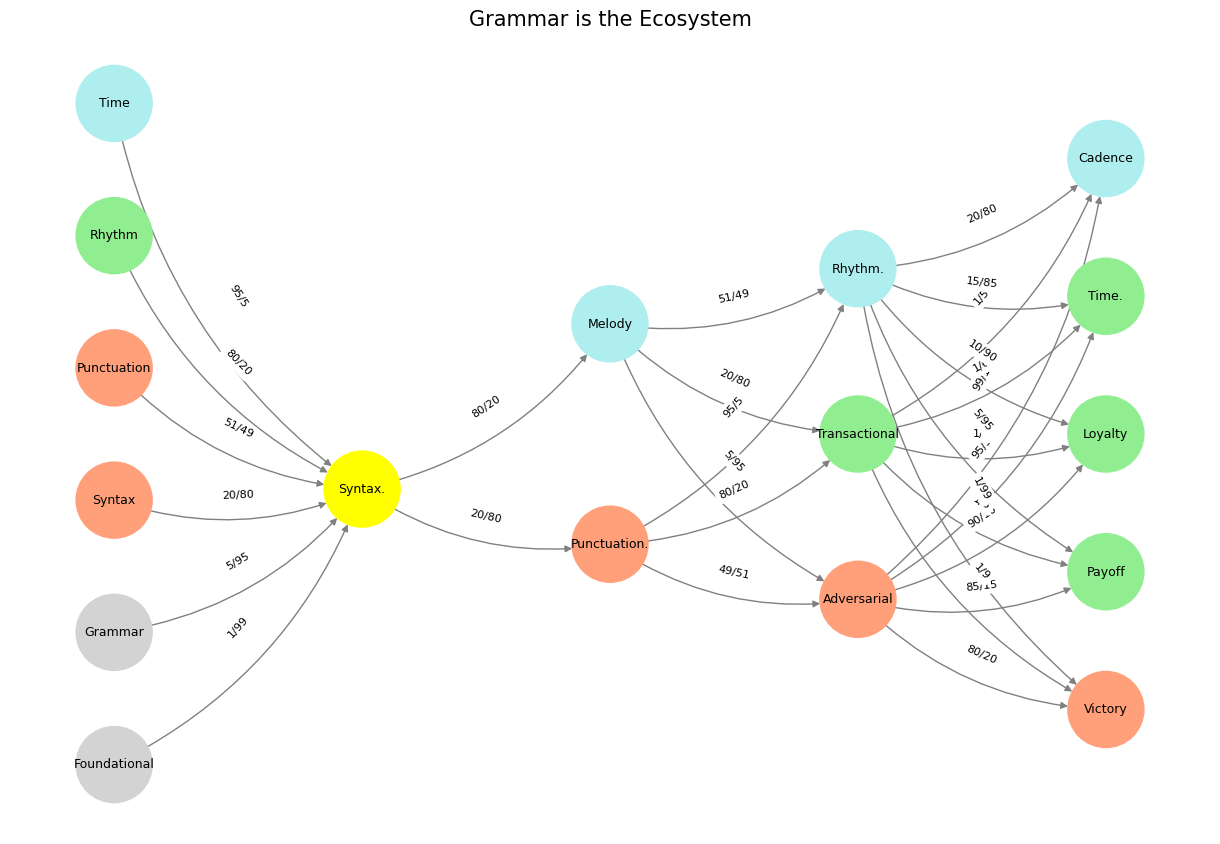Veiled Resentment#
Language, like tragedy, is born from a fundamental tension—an Apollonian architecture of rules and order, and a Dionysian surge of feeling, rhythm, and flux. If grammar is Apollonian, constructing language through rational principles, then prosody is Dionysian, sweeping through it with the passion and musicality that transform syntax into living speech. Friedrich Nietzsche’s vision in The Birth of Tragedy—wherein the rigid clarity of Apollo meets the intoxicating frenzy of Dionysus—illuminates this interplay. The very spirit of music, which Nietzsche saw as the primal force underlying Greek tragedy, manifests in prosody, the musical dimension of speech. Without it, language would be a lifeless scaffold, a skeletal structure devoid of breath and motion. Yet without grammar, prosody would dissolve into incoherence, a pure Dionysian flood with no Apollonian form to contain it.

Fig. 23 Inheritence, Heir, Brand, Tribe, Religion. We’ve described these stages of societal history. We’re discussing brand: an agent exerts an ecological loss function that some consider “creative destruction”.#
Apollo governs the grammatical, structural elements of language, the domain of syntax, morphology, and rules that impose order upon words. The left hemisphere of the brain, particularly Brodmann’s Area 22, functions as Apollo’s architect, assembling meaning with precision. It dictates subject-verb agreement, case endings, and the logic of subordination. It is the source of linguistic clarity, ensuring that meaning is conveyed with mathematical exactness. In this Apollonian realm, words are tokens of fixed value, their relationships governed by well-defined principles. A noun must agree with its adjective, a verb must align with its subject, and the placement of a modifier determines whether a sentence makes sense or collapses into ambiguity.
But prosody, like Dionysus, resists such strictures. It spills over them, bending and stretching meaning in ways that formal grammar cannot contain. It is not bound by syntax but moves through pitch, stress, and rhythm, shaping language in ways that defy rigid categorization. The right hemisphere, the seat of prosodic processing, does not analyze language in discrete units but absorbs its flow as a gestalt, recognizing irony, sarcasm, and the ineffable tones of human emotion. It is here that speech transcends mere structure and takes on its musical quality. It is here that tragedy is born—not from logic alone, but from the deep, undulating currents of human experience that prosody conveys. A monotonous recitation of Shakespeare would drain his words of their tragic force, just as the tragedies of Aeschylus would be meaningless without the rhythmic intensity of choral odes and the metrical pulse that drives them forward.
The interplay of these forces is most evident in the way prosody can defy grammatical expectation. Consider a sentence like You’re going. In isolation, it is a statement, grammatically unambiguous. But the moment prosody intervenes, its meaning becomes uncertain. If the final word is drawn upward in pitch, it is no longer a declaration but a question. If spoken with clipped, descending intonation, it might be an accusation. If infused with a rolling, musical lilt, it becomes playful or seductive. Here, Dionysus laughs in Apollo’s carefully ordered halls, revealing that meaning is not dictated solely by grammatical structure but by the musical inflection that gives words their emotional life. The same sentence, unchanged in syntax, can carry command, doubt, sarcasm, or tenderness, depending on the shape prosody imposes upon it.
Nietzsche saw the dissolution of tragedy in the Socratic turn—the reduction of Dionysian intensity into Apollonian clarity, the sacrifice of instinct to reason. One might say the same for language when grammar overtakes prosody entirely. When speech is reduced to mere words on a page, devoid of stress and rhythm, much of its richness is lost. Writing, by its very nature, is an Apollonian form, freezing the dynamism of spoken language into fixed symbols. The best literature, however, finds ways to restore Dionysian motion to its Apollonian stillness, through poetic meter, through rhetorical cadence, through the echo of music in the written word.
Yet the reverse is also true. A purely Dionysian mode of language—one governed only by prosody, without grammatical structure—would be incoherent. A scream, a moan, a wail—these are forms of prosodic expression, raw and primal, yet they do not constitute language until they are shaped into form. The tragic chorus, though wild and ecstatic, still adheres to metrical constraints. Music, for all its freedom, still follows patterns, repetitions, and harmonic structures. Dionysus alone does not create tragedy—he requires Apollo to frame the vision, to give structure to the storm.
Brodmann’s Area 22, divided between left and right hemispheres, is the anatomical proof of this duality, mirroring Nietzsche’s metaphysical claim that art and language arise from the conflict between order and chaos. The left hemisphere constructs, the right hemisphere emotes. The left encodes rules, the right injects spirit. But neither is complete without the other. Tragedy dies when Dionysus is banished, but it is never born at all without Apollo’s hand to sculpt it into form.
Thus, the birth of language out of the spirit of music is the birth of tragedy itself. The Apollonian framework of grammar allows language to be intelligible, but it is the Dionysian force of prosody that makes it alive. Their fusion is the essence of all great speech, all great poetry, all great tragedy. It is why a line of Shakespeare spoken by an actor can be a revelation, while the same line read silently may seem only a sequence of words. It is why a song lyric, stripped of its melody, may read as banal, yet sung aloud, it can move a listener to tears. Language is never merely logical or merely musical—it is always both, always a fragile balance between Apollo and Dionysus, forever dancing at the edge of meaning.
Show code cell source
import numpy as np
import matplotlib.pyplot as plt
import networkx as nx
# Define the neural network layers
def define_layers():
return {
'Suis': ['Foundational', 'Grammar', 'Syntax', 'Punctuation', "Rhythm", 'Time'], # Static
'Voir': ['Syntax.'],
'Choisis': ['Punctuation.', 'Melody'],
'Deviens': ['Adversarial', 'Transactional', 'Rhythm.'],
"M'èléve": ['Victory', 'Payoff', 'Loyalty', 'Time.', 'Cadence']
}
# Assign colors to nodes
def assign_colors():
color_map = {
'yellow': ['Syntax.'],
'paleturquoise': ['Time', 'Melody', 'Rhythm.', 'Cadence'],
'lightgreen': ["Rhythm", 'Transactional', 'Payoff', 'Time.', 'Loyalty'],
'lightsalmon': ['Syntax', 'Punctuation', 'Punctuation.', 'Adversarial', 'Victory'],
}
return {node: color for color, nodes in color_map.items() for node in nodes}
# Define edge weights (hardcoded for editing)
def define_edges():
return {
('Foundational', 'Syntax.'): '1/99',
('Grammar', 'Syntax.'): '5/95',
('Syntax', 'Syntax.'): '20/80',
('Punctuation', 'Syntax.'): '51/49',
("Rhythm", 'Syntax.'): '80/20',
('Time', 'Syntax.'): '95/5',
('Syntax.', 'Punctuation.'): '20/80',
('Syntax.', 'Melody'): '80/20',
('Punctuation.', 'Adversarial'): '49/51',
('Punctuation.', 'Transactional'): '80/20',
('Punctuation.', 'Rhythm.'): '95/5',
('Melody', 'Adversarial'): '5/95',
('Melody', 'Transactional'): '20/80',
('Melody', 'Rhythm.'): '51/49',
('Adversarial', 'Victory'): '80/20',
('Adversarial', 'Payoff'): '85/15',
('Adversarial', 'Loyalty'): '90/10',
('Adversarial', 'Time.'): '95/5',
('Adversarial', 'Cadence'): '99/1',
('Transactional', 'Victory'): '1/9',
('Transactional', 'Payoff'): '1/8',
('Transactional', 'Loyalty'): '1/7',
('Transactional', 'Time.'): '1/6',
('Transactional', 'Cadence'): '1/5',
('Rhythm.', 'Victory'): '1/99',
('Rhythm.', 'Payoff'): '5/95',
('Rhythm.', 'Loyalty'): '10/90',
('Rhythm.', 'Time.'): '15/85',
('Rhythm.', 'Cadence'): '20/80'
}
# Calculate positions for nodes
def calculate_positions(layer, x_offset):
y_positions = np.linspace(-len(layer) / 2, len(layer) / 2, len(layer))
return [(x_offset, y) for y in y_positions]
# Create and visualize the neural network graph
def visualize_nn():
layers = define_layers()
colors = assign_colors()
edges = define_edges()
G = nx.DiGraph()
pos = {}
node_colors = []
# Add nodes and assign positions
for i, (layer_name, nodes) in enumerate(layers.items()):
positions = calculate_positions(nodes, x_offset=i * 2)
for node, position in zip(nodes, positions):
G.add_node(node, layer=layer_name)
pos[node] = position
node_colors.append(colors.get(node, 'lightgray'))
# Add edges with weights
for (source, target), weight in edges.items():
if source in G.nodes and target in G.nodes:
G.add_edge(source, target, weight=weight)
# Draw the graph
plt.figure(figsize=(12, 8))
edges_labels = {(u, v): d["weight"] for u, v, d in G.edges(data=True)}
nx.draw(
G, pos, with_labels=True, node_color=node_colors, edge_color='gray',
node_size=3000, font_size=9, connectionstyle="arc3,rad=0.2"
)
nx.draw_networkx_edge_labels(G, pos, edge_labels=edges_labels, font_size=8)
plt.title("Grammar is the Ecosystem", fontsize=15)
plt.show()
# Run the visualization
visualize_nn()


Fig. 24 Aristotle’s method is top-down and deductive, beginning with axiomatic truths and using logical syllogisms to derive conclusions, prioritizing internal consistency over empirical verification. His framework assumes that if the premises are sound, the conclusion necessarily follows, reinforcing a stable, hierarchical knowledge system rooted in classification and definition. Bacon, in stark contrast, rejects this static certainty in favor of a bottom-up, inductive approach that builds knowledge through systematic observation, experimentation, and external testing. Rather than accepting inherited truths, Bacon’s method accumulates empirical data, refines hypotheses through iteration, and subjects knowledge to real-world scrutiny, making it adaptive, self-correcting, and ultimately more aligned with the unpredictability of nature.#

